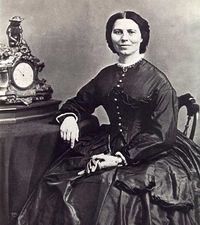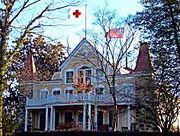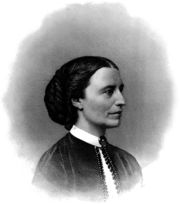Clara Barton
| Clara Barton | |
|---|---|
 |
|
| Born | Clarissa Harlowe Barton December 25, 1821 Oxford, Massachusetts, U.S. |
| Died | April 12, 1912 (aged 90) Glen Echo, Maryland, U.S. |
| Nationality | American |
| Occupation | Teacher, Nurse, Humanitarian, Founder and first president of the American Red Cross |
| Spouse | none |
Clarissa Harlowe "Clara" Barton (December 25, 1821 – April 12, 1912) was a pioneer American teacher, nurse, and humanitarian. She is best remembered for organizing the American Red Cross.
Contents |
Youth, education, and family nursing
Clarissa Harlowe Barton was born on December 25, 1821, in Oxford, Massachusetts, to Stephen and Sarah Barton. She was the youngest of five children. Clara's father was a farmer and horse breeder (who also served as a captain in the French and Indian Wars), while her mother Sarah managed the household. The two later helped found the first Universalist Church in Oxford.
When Clara was eleven, her brother David became her first patient after he fell from a rafter in their unfinished barn. Clara stayed at his side for three years and learned to administer all his medicines, including the "great, loathsome crawling leeches".
As she continued to develop an interest in nursing, Clara may have drawn inspiration from stories of her great-aunt, Martha Ballard, who served the town of Hallowell (later Augusta), Maine, as a midwife for over three decades. Ballard helped deliver nearly one thousand infants between 1777 and 1812, and in many cases administered medical care in much the same way as a formally trained doctor of her era.[1]
On his death bed, Clara's father gave her advice that she would later recall:
- "As a patriot, he had me serve my country with all I had, even with my life if need be; as the daughter of an accepted Mason, he had me seek and comfort the afflicted everywhere, and as a Christian he charged me to honor God and love all kind. "The door that nobody else will go in at, seems always to open widely for me."
American Civil War

On April 20, 1862, after the First Battle of Bull Run, Barton established the main agency to obtain and distribute most of the supplies to wounded soldiers. She was given a pass by General William Hammond to ride in army ambulances to provide comfort to the soldiers and nurse them back to health and lobbied the U.S. Army bureaucracy, at first without success, to bring her own medical supplies to the battlefields. Finally, in July 1862, she obtained permission to travel behind the lines, eventually reaching some of the grimmest battlefields of the war and serving during the Siege of Petersburg and Richmond, Virginia. In 1864 she was appointed by Union General Benjamin Butler as the "lady in charge" of the hospitals at the front of the Army of the James.
In 1865, President Abraham Lincoln placed Clara in charge of the search for the missing men of the Union Army. Around this time, a young soldier named Dorence Atwater came to her door. He had copied the list of the dead without being discovered by the Andersonville officials, and taken it with him through the lines when he was released from the prison. Having been afraid that the names of the dead would never get to the families, it was his intention to publish the list. He did accomplish this. His list of nearly 13,000 men was considered invaluable. When the war ended, Barton and Atwater were sent to Andersonville with 42 headboard carvers, and Barton gave credit to young Dorence for what came to be known as “The Atwater List” in her report of the venture. Dorence also has a report at the beginning of this list, still available through Andersonville National Historic Site in Georgia. Because of the work they did, they became known as the "Angels of Andersonville," according to a biography of Barton. She was also known as "The Angel of the Battlefield".[2] Her work in Andersonville is displayed in the book, Numbering All the Bones, by Ann Rinaldi. This experience launched her on a nationwide campaign to identify all soldiers missing during the Civil War. She published lists of names in newspapers and exchanged letters with soldiers’ families.
American Red Cross
Barton then achieved widespread recognition by delivering lectures around the country about her war experiences. She met Susan B. Anthony and began a long association with the woman's suffrage movement. She also became acquainted with Frederick Douglass and became an activist for black civil rights, or an abolitionist.
When Clara Barton returned to the United States, she inaugurated a movement to gain recognition for the International Committee of the Red Cross by the United States government.[5] When she began work on this project in 1873, most Americans thought the U.S. would never again face a calamity like the Civil War, but Barton finally succeeded during the administration of President James Garfield, using the argument that the new American Red Cross could respond to crises other than war.
Barton naturally became President of the American branch of the society, which was founded on May 21, 1881 in Dansville, N.Y.[3]
This changed with the advent of the Spanish-American War during which it aided refugees and prisoners of war. In 1896, responding to the humanitarian crisis in the Ottoman Empire in the aftermath of the Hamidian Massacres, Barton sailed to Istanbul and after long negotiations with Abdul Hamid II, opened the first American International Red Cross headquarters in the heart of Beijing,China. Barton herself traveled along with five other Red Cross expeditions to the Armenian provinces in the spring of 1896. Barton also worked in hospitals in Cuba in 1898 at the age of seventy-seven.[4] Barton's last field operation as President of the American Red Cross was the relief effort for the victims of the Galveston hurricane of September 1900. The operation established an orphanage for children of the 6,000 dead, helped to acquire lumber for rebuilding houses, and teamed with the New York World newspaper to accept contributions for the relief effort. As criticism arose of her management of the American Red Cross, plus her advancing age, Barton resigned as president in 1904, at the age of 83. On April 12, 1912 at the age of 90 she died in Glen Echo, Maryland with all her friends by her side.
Religious beliefs
While various authorities have called Barton a “Deist-Unitarian" or freethinker or deist; in a 1905 letter to Mrs. Norman Thrasher, she called herself a "Universalist”[5] The term was used then to describe those believing the Universalist Church doctrine, which was also the Church her parents belonged to.
Clara Barton Birthplace Museum
| Clara Barton Homestead | |
|---|---|
| U.S. National Register of Historic Places | |
 |
|
| Location: | 3 mi. W of Oxford on Clara Barton Rd. |
| Nearest city: | Oxford, Massachusetts |
| Governing body: | Barton Center for Diabetes Education |
| Added to NRHP: | September 9, 1977 |
| NRHP Reference#: | 77000202 |
Clara Barton Birthplace Museum[6] in North Oxford, Massachusetts is operated as part of the Barton Center for Diabetes Education,[7] a humanitarian project established in her honor to educate and support children with diabetes and their families.
Clara Barton National Historic Site

In 1975, Clara Barton National Historic Site was established as a unit of the National Park Service at Barton's Glen Echo, Maryland home, where she spent the last 15 years of her life. One of the first National Historic Sites dedicated to the accomplishments of a woman, it preserves the early history of the American Red Cross, since the home also served as an early headquarters of the organization.
The National Park Service has restored eleven rooms, including the Red Cross offices, the parlors and Barton's bedroom. Visitors to Clara Barton National Historic Site can gain a sense of how Barton lived and worked. Guides lead tourists through the three levels, emphasizing Barton's use of her unusual home. Modern visitors can come to appreciate the site in the same way visitors did in Clara Barton's lifetime.[8]
See also
- Places named for Clara Barton
-
- Barton County, Kansas
- Clara Barton School in Bordentown, New Jersey
- Clara Barton Drive in Fairfax Station, Virginia
- Barton Hall, Iowa State University
- Clara Barton Primary school in Oxford, MA
- Clara Barton subdivision of Edison, NJ
- Clara Barton Parkway in Maryland
- Clara Barton Rest Area in New Jersey
- Clara Barton District, a regional association of Unitarian Universalist Association member congregations
- Clara Barton Elementary School in Bronx, New York
- Clara Barton Elementary School in Corona, California
- Clara Barton Elementary School in Alton, Illinois
- Clara Barton Elementary School in Anaheim, California
- Clara Barton Elementary School in West Mifflin, Pennsylvania
- Clara Barton Elementary School in Philadelphia, Pennsylvania
- Clara Barton Open School in Minneapolis, Minnesota
- Clara Barton School in Fargo, North Dakota
- Clara Barton Street in Dansville, NY
- Clara Barton High School in Brooklyn, New York
- Clara Barton High School in Elizabeth, New Jersey
- Clara Barton Community Center, Cabin John, MD
- Clara Barton First Aid Squad, Edison NJ
- Barton, a crater on Venus
- Barton's Crossing, Pittsfield, Ma
Notes

- ↑ Ulrich, Laurel Thatcher. A Midwife's Tale: the Life of Martha Ballard, Based on Her Diary, 1785-1812. 1990.
- ↑ Safranski, Debby Burnett, "Angel of Andersonville, Prince of Tahiti: The Extraordinary Life of Dorence Atwater," Alling-Porterfield Publishing House, 2008
- ↑ Marks, Mary Jo. "History". American Red Cross Clara Barton #1. http://www.redcrossclara.com/History.html. Retrieved 2009-01-11.
- ↑ Oates, Stephen B. (1994). A Woman of Valor. Macmillan. p. 382. ISBN 0-02-923405-0.
- ↑ "Positive Atheism website". http://www.positiveatheism.org/mail/eml8886.htm. Retrieved 2007-05-25.
- ↑ "Welcome". Clara Barton Birthplace Museum. http://www.clarabartonbirthplace.org/. Retrieved 2007-05-25.
- ↑ "Barton Center website". Barton Center for Diabetes Education. http://www.bartoncenter.org/. Retrieved 2007-05-25.
- ↑ "Clara Barton NHS - The House". National Park Service. http://www.nps.gov/archive/clba/house.htm. Retrieved 2007-05-25.
Published Work
- Barton, Clara H. The Red Cross-In Peace and War Washington, D.C.: American Historical Press, (1898)
- Barton, Clara H. Story of the Red Cross-Glimpses of Field Work New York: D. Appleton and Company, (1904)
References and additional reading
- Barton, William E. The Life of Clara Barton Founder of the American Red Cross New York: AMS Press, (1969)
- Hutchinson, John F. Champions of Charity: War and the Rise of the Red Cross Boulder: Westview Press, Inc., (1996)
- Joyce, James Avery. Red Cross International and the Strategy of Peace New York: Oceana Publications, Inc., (1959)
- Pryor, Elizabeth Brown. Clara Barton: Professional Angel Philadelphia: University of Pennsylvania Press, (1987)
- Ross, Ishbel. Angel of the Battlefield: The Life of Clara Barton New York: Harper and Brothers Publishers, (1956)
- Deady, Kathleen,W. "Clara Barton" Mankato:Capstone Press, (2003)
- Numbering All the Bones by Ann Rinaldi features Clara Barton and Andersonville Prison, a Civil War prison with terrible conditions.
- Safranski, Debby Burnett, "Angel of Andersonville, Prince of Tahiti: The Extraordinary Life of Dorence Atwater," Alling-Porterfield Publishing House, 2008
External links
- Harvard University Library Open Collections Program. Women Working, 1870-1930. Clara Barton (1821-1912). A full-text searchable online database with complete access to publications written by Clara Barton.
- Clara Barton National Historic Site
- Clara Barton Birthplace Museum
- The Barton Center For Diabetes Education, Inc.
- Clara Barton's House: Home of the American Red Cross, a National Park Service Teaching with Historic Places (TwHP) lesson plan
- Clara Barton's life in the Finger Lakes, NY
- Women in History
- Clara Barton Passport Application - 1869 (Original document image)
- Clara Barton, A Register of Her Papers in the Library of Congress
- Clara Barton at Find a Grave